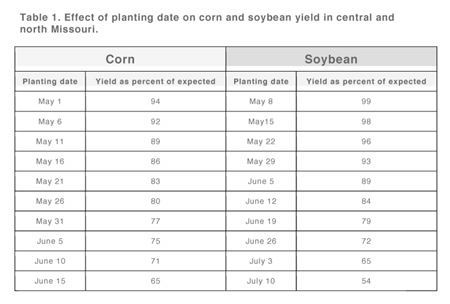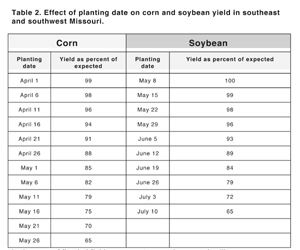Missouri Flooding Impact On Corn And Soybean Survival
GREGORY A. LUCE
COLUMBIA, MO.
The historic rainfall and subsequent flooding across portions of central and southern Missouri have done tremendous damage to property. Farmers with crops planted in fields that are now flooded or saturated will be making evaluations on their corn and soybean stands. There are many factors that determine how well a seedling crop will tolerate flooding. The most important factors on flooded corn and soybean fields are:
1. Duration of the flooding
2. Temperature during the flood
3. Rate of drying and conditions just after the flooding event
Research in flooded soils has shown that the oxygen concentration drops rapidly and is nearly depleted in 24 to 48 hours, however, moderate water movement allows some oxygen to get to the plants, and damage is not as severe. Oxygen is critical for the plant to perform basic functions including respiration, water uptake and root growth. Water-logging also leads to accumulations of compounds like CO2, which are toxic to plants in high concentrations.
Young corn can survive flooded conditions lasting for about 2 days under warm temperatures (at or above mid-70s°F) to 4 days under cooler temperatures (at or below mid-60s°F). Survivability also is influenced by how much of the plant was submerged and how quickly the water recedes. Corn plants that survived flooded conditions should show new leaf development within 3 to 5 days after water recedes. Generally, soybeans tolerate 48 hours under water quite well. Flooding for 4 days or more can significantly reduce stands, vigor, and yield. Flooded and saturated conditions also restrict root development, thereby reducing the crop's ability to take up water and nutrients and tolerate drought stress later in the season.
Growth stage is a critical factor in survivability due to flooding. While a larger plant requires more oxygen to stay alive, smaller plants are more likely to become completely submerged and to remain submerged for longer periods.
Temperature makes a difference. If temperatures are abnormally warm during the flooding period, the crop survival period may be reduced by 50 percent or more. Conversely, if temperatures are cool, like they have been recently, the survival of the submerged crop increases because its metabolic processes are slowed down. Cloudy conditions decrease solar radiation and keep soils and floodwaters cooler. The down side is that cold, wet weather favors disease. Plants can be slow to recover when water recedes. Long-term impacts on the crop are often related to disease infection and retarded root development that limits access to available subsoil moisture later in the season.
Cool, wet soils are ideal for some disease development. These conditions are not only optimal for some soil pathogens, but delay plant growth and development. Delayed development can allow plants to be more susceptible to damage by soil-borne diseases that attack seeds and seedlings. Seed treatments have been shown to help, but typically only provide protection for a couple of weeks. If cool, wet conditions persist longer than two to three weeks, crop stands can be at risk. Pythium is a common disease that tends to cause the most damage to seedlings of soybean or corn, and Phytophthora can damage soybean seedlings or start infections in the early summer that may develop and kill soybean plants later in the summer.
It is important to note that the impacts of saturated and ponded areas of fields is similar in the effect on seedling corn and soybean plants as those fields that experience flooded conditions.
Replant Decisions:
Deciding whether or not to replant can be a tough decision but there are some key factors to keep in mind. The effectiveness of replanting will be affected by the combination of planting date and changing environmental conditions. It is important to make the decision based on economics and not emotions. It is also important to be patient in waiting for soil conditions to be satisfactory. While this is easier said than done, jumping into the field when it is not ready can cause problems that are not easily corrected.
Below is a list of items from Dr. Bill Wiebold and Dr. Ray Massey that should be considered when making a replant decision:
• Determine the cause of the sparse stand.
• Determine the stand density and condition of the stand.
• Determine the yield potential of the sparse stand.
• Estimate the expected gross revenue from the sparse stand.
• Estimate the cost to replant.
• Estimate the yield potential and gross revenue from a replanted stand.
• Determine whether replanting will pay for itself.
The tables provide an estimate of percent yield potential when planting corn or soybean at various dates in the season.
In the case of flooded fields, once water recedes, growth will resume approximately within 3 to 5 days, this is the time to begin evaluating corn stand and plant survivability. For corn a healthy radicle root and coleoptile should be white to cream color. Conduct stand counts and utilize replant decision guides to make a determination whether to keep the existing stand. Refer to MU guide 4091: “Corn and Soybean Replant Decisions” at the following link: http://extension.missouri.edu/p/G4091 for more information.
If corn is to be chemically killed, refer to the recent IPCM Article from Dr. Kevin Bradley titled: Herbicide Options for Killing Failed Corn Stands
Stick with your plans for corn and soybeans and don’t switch corn hybrids too soon.
Yield expectations of corn planted in May are very good and there is no reason to consider switching crops or to a shorter season hybrid in May. With the growing season in Missouri, full season hybrids are safe planted into June. There is a grain moisture advantage for early to mid-season corn hybrids over full season products that may come into consideration in late May or June. However, for now, staying with intended hybrids is the best choice.
Researchers in Indiana and Ohio (Nielsen et al. 2002) planted corn at three dates between late April and June. It was found that later planted corn matured with an average of 9 days less in total days than earlier planted corn. This average includes both short and long season hybrids.
This data shows that full season hybrids shorten up GDU requirements with late planting and thus allow them to be planted later and still have time to dry down adequately. Switching from a very full season hybrid in late May or early June, to a somewhat earlier hybrid would provide some drydown advantage but avoid switching to very early hybrids that are not adapted to the area. Considering the Purdue/Ohio State data, and past experience in Missouri, it is recommended to stay with normal intentions throughout May. ∆
GREGORY A. LUCE: Instructor, Adjunct Plant Sciences, University of Missouri

